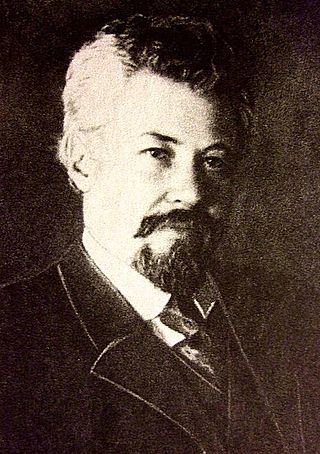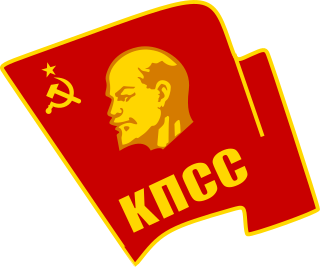 |
|---|
The Democratic Bloc (Estonian : Demokraatlik Blokk) was a political grouping in Estonia.
 |
|---|
The Democratic Bloc (Estonian : Demokraatlik Blokk) was a political grouping in Estonia.
The Bloc was formed in 1917 by the Estonian Democratic Party, the Estonian Radical Democratic Party and the Rural League. [1] Between them the parties had won 24 of the 62 seats in the Provincial Assembly elections in the same year. [2]
In the Russia-wide elections in November 1917, the Democratic Bloc received around 23% of the vote in the Autonomous Governorate of Estonia. [3] In the Estonian Constituent Assembly elections the following year, the Bloc maintained its vote share at around 23%. [4]
In March 1919 the Estonian Democratic Party and Estonian Radical Democratic Party merged to form the Estonian People's Party, [1] with the Rural League remaining a separate party.
The Estonian Provincial Assembly or Estonian State Diet, also often called by its Estonian name Maapäev, was elected in May–June 1917 during the Russian Revolution as the provincial parliament (diet) of the Autonomous Governorate of Estonia. On 28 November 1917, after the October Revolution in Russia, the Assembly declared itself the sole sovereign power in Estonia and called for the elections of the Estonian Constituent Assembly. On the eve of the German occupation of Estonia during World War I the council elected the Estonian Salvation Committee and issued the Estonian Declaration of Independence on 24 February 1918.

The All India Forward Bloc (abbr.AIFB) is a left-wing nationalist political party in India. It emerged as a faction within the Indian National Congress in 1939, led by Subhas Chandra Bose. The party re-established as an independent political party after the independence of India. During the 1951–1952 and 1957 Indian general election, the party was known as Forward Bloc (Marxist). It has its main stronghold in West Bengal. The party's current Secretary-General is G. Devarajan. Veteran Indian politicians Sarat Chandra Bose (brother of Subhas Chandra Bose) and Chitta Basu had been the stalwarts of the party in independent India.

The Governorate of Estonia, also known as the Esthonia (Estland) Governorate, was a province (guberniya) and one of the Baltic governorates of the Russian Empire. It was located in the northern Estonia with some islands in the West Estonian archipelago, including Hiiumaa and Vormsi. Previously, the Reval Governorate existed during Peter I's reign and was confirmed by the Treaty of Nystad, which ceded territory from Sweden to the newly established Russian Empire. The Estonia Governorate was established in 1796 when Paul I's reforms abolished the Reval Viceroyalty. The port city of Reval was the administrative centre where the governor had his seat.

The Union of Democratic Forces is a political party in Bulgaria, founded in 1989 as a union of several political organizations in opposition to the communist government. The Union was transformed into a single unified party with the same name. The SDS is a member of the European People's Party (EPP). In the 1990s the party had the largest membership in the country, with one million members, but has since splintered into a number of small parties totaling no more than 40,000 members. The SDS proper had 12,000 members in 2016.

Elections to the Russian Constituent Assembly were held on 25 November 1917, although some districts had polling on alternate days, around two months after they were originally meant to occur, having been organized as a result of events in the February Revolution. They are generally recognised to be the first free elections in Russian history. The dissolution of the Constituent Assembly was also approved by the Left Socialist Revolutionaries and anarchists; both groups were in favour of a more extensive democracy.

Svetozar Pribićević was a Croatian Serb politician in Austria-Hungary and later Kingdom of Yugoslavia. He was one of the main proponents of Yugoslavism and a federalized South Slavic state which would later turn out to be Yugoslavia. However, he later became a bitter opponent of the same policy that was promoted by King Alexander I.

The Communist Party of Estonia was a regional branch of the Soviet communist party which in 1920–1940 operated illegally in Estonia and, after the 1940 occupation and annexation of the country by the Soviet Union, was formally re-merged into the USSR's All-Union Communist Party (bolsheviks) and operated as part of the CPSU until 1990.
The Democratic Alliance, originally called Democratic Republican Alliance, was a French political party created in 1901 by followers of Léon Gambetta such as Raymond Poincaré, who would be president of the Council in the 1920s. The party was originally formed as a centre-left gathering of moderate liberals, independent Radicals who rejected the new left-leaning Radical-Socialist Party, and Opportunist Republicans, situated at the political centre and to the right of the newly formed Radical-Socialist Party. However, after World War I and the parliamentary disappearance of monarchists and Bonapartists it quickly became the main centre-right party of the Third Republic. It was part of the National Bloc right-wing coalition which won the elections after the end of the war. The ARD successively took the name "Democratic Republican Party", and then "Social and Republican Democratic Party", before becoming again the AD.
The Georgian Socialist-Federalist Revolutionary Party was a Georgian nationalist party, founded in April 1904. The party's program demanded the national autonomy of Georgia, within the framework of a Russian federal state, and advocated for a democratic socialist system. Mainly based in the rural areas, the party's membership was almost entirely drawn from the peasantry and the petty gentry. The political profile of the party had an appeal amongst moderately nationalist intellectuals, schoolteachers and students. The party strived that agricultural issues not be decided by central authorities, but by autonomous national institutions. The party published the periodical Sakartvelo.
The Estonian Liberal Democratic Party, abbreviated to ELDP, was a social liberal political party in Estonia that existed between 1990 and 1994. The ELDP was founded on 9 March 1990, during the Estonian Soviet Socialist Republic, by the merger of the Liberal People's Party and the Free Democratic Party.
The Estonian Labour Party was a political party in Estonia. It was formed in 1919 by a merger of the Radical Socialist Party and the Social Travaillist Party, and ceased to exist in 1932, when it merged with other centrist parties to form the National Centre Party. It was a member of government coalitions between 1919 and 1925, and again from 1927 until 1931.
The Estonian Radical Socialist Party was a political party in Estonia.
The Estonian People's Party was a centre-right political party in Estonia.

The Farmers' Assemblies was a conservative political party in Estonia. Led by Konstantin Päts, it was one of the ruling parties during most of the interwar period.
The Social Travaillist Party was a political party in Estonia.
The Estonian Radical Democratic Party was a political party in Estonia.
The Estonian Democratic Party was a political party in Estonia.

There are numerous, conflicting accounts on the outcome of the November–December 1917 election to the All-Russian Constituent Assembly. The Constituent Assembly election, which took place in the midst of the First World War and the October Revolution, was the largest exercise of universal suffrage in the history of mankind until that date. Spanning over decades, different historical research projects have been undertaken to try to map the puzzle of outcomes of the election from the various constituencies.

The Priamur electoral district was a constituency created for the 1917 Russian Constituent Assembly election. The Priamur electoral district consisted of the Amur Oblast, the Maritime Province and the Sakhalin Oblast. However, local leaders had preferred to have three separate constituencies. The election was held on time in the constituency.

The Estonia electoral district was a constituency created for the 1917 Russian Constituent Assembly election, covering the Autonomous Governorate of Estonia.